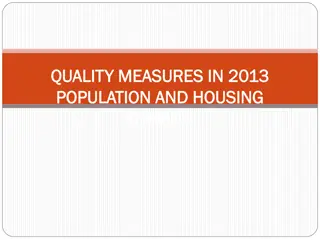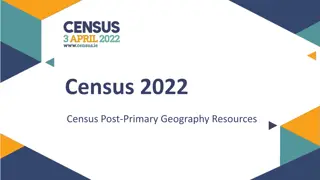Risk Management and Contingency Planning in Canadian Census Program
Effective risk management and contingency planning were vital for the Canadian Census of Population Program in December 2022. Prior to operations, risks were identified, evaluated, and mitigation plans were established. During operations, a virtual operational command center was utilized due to COVID-19 risks. Various risks, such as natural disasters and system outages, partially materialized during the program. Contingency planning included the use of administrative data for post-collection imputation when disasters prevented traditional census enumeration. Statistics Canada successfully implemented a statistical contingency plan in response to COVID-19 challenges.
Download Presentation

Please find below an Image/Link to download the presentation.
The content on the website is provided AS IS for your information and personal use only. It may not be sold, licensed, or shared on other websites without obtaining consent from the author.If you encounter any issues during the download, it is possible that the publisher has removed the file from their server.
You are allowed to download the files provided on this website for personal or commercial use, subject to the condition that they are used lawfully. All files are the property of their respective owners.
The content on the website is provided AS IS for your information and personal use only. It may not be sold, licensed, or shared on other websites without obtaining consent from the author.
E N D
Presentation Transcript
Risk management/contingency planning Risk management/contingency planning Canadian Census of Population Program December, 2022
Managing risks prior to operations Managing risks prior to operations Early identification and ongoing evaluation with census managers of strategic risks and establishment of project risk register Fast adaptation to COVID-19 Internal audit requested to identified opportunity to strengthen mitigation and contingency plans Risk playbooks, walkthroughs successful (2020-21)
Managing risks during operations Managing risks during operations Management information systems and virtual operational command centre. Physical command centre developed, but not used due to COVID risk Had an incident management process ready to be used during operations, activated as necessary Used group text messaging, with Teams meetings as required
Risks that materialized (fully or partially) Risks that materialized (fully or partially) Natural disaster, public health Wave timing & model Program targets Systems outages Cost COVID-19 facility closures collection plan print and postal partners (minor) on-boarding of virtual field staff Electronic questionnaire minor outages only Wave 3 mail-out printing of letter in envelope vs. self- mailer budget request to address pandemic Schedule NRFU +2 wks Canvasser reserve +6 wks Self response +6 wks Collection management portal minor outages only NRFU workload NRFU started before some letters received in Ontario more NRFU (also due to response) + Fires West and Ontario limited access to canvasser reserve Response rate some localised impacts, not overall Responses: Extensive planning Redundancy Responses: Re-planning, e.g. socially distanced collection, no early enumeration, no fingerprinting Virtual workforce, including CHL Longer collection Responses: Planned over-hiring of NRFU staff Longer collection Responses: FEFU during NRFU Admin data where possible Longer collection Staggered data processing
Contingency planning Contingency planning In the event that COVID-19 or other disasters prevented the traditional census from a satisfactory enumeration Statistics Canada developed a statistical contingency plan based on the use of administrative data for post-collection imputation of 2021 Census non-responding households Low scale implementation: 1,045 collection geographies (out of 49,000 in Canada) showed a response rate below 90%. Dwellings that had good quality administrative data were in-scope. About 12,000 non-responding households representing less than 0.1% of occupied private dwellings in Canada
Discussion Discussion What are your thoughts on: Documenting risks? Developing and executing an effective emergency management plan? Effective pre-operational preparation (practice sessions etc)? Being flexible and lean enough to respond quickly and effectively to the unexpected? Developing contingency plans?























